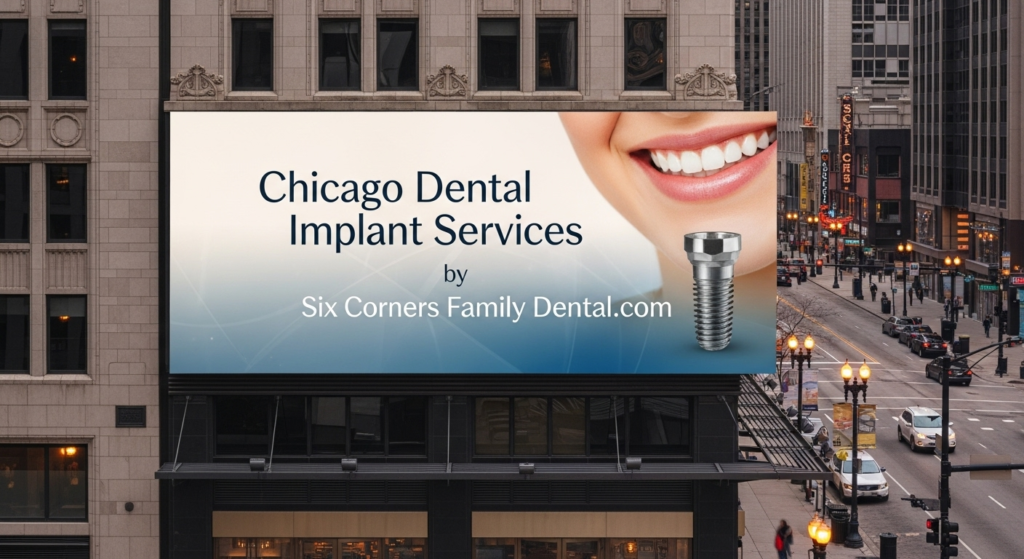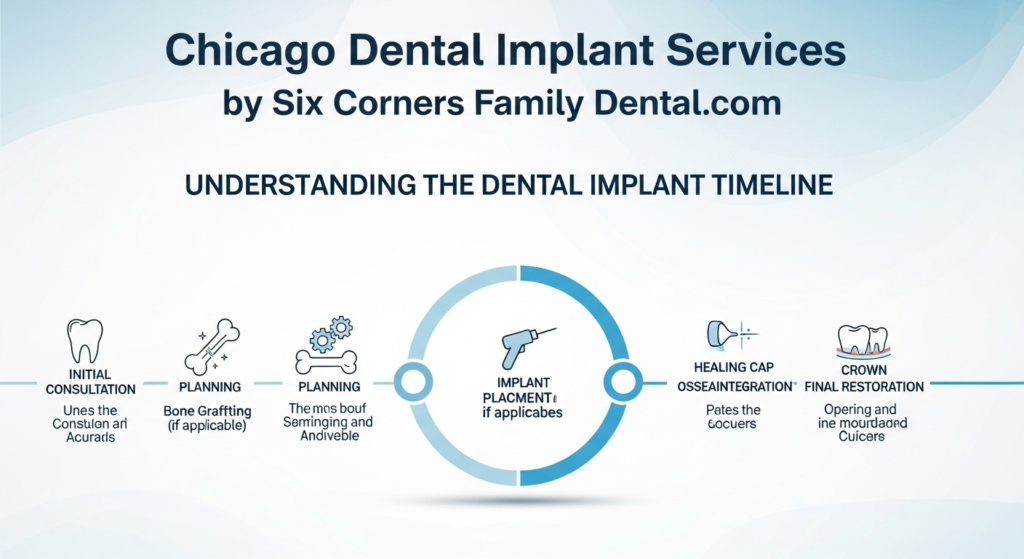
Chicago Dental Implants: Understanding Implant Timeline
Dental implants are a long-term investment in your health, confidence, and quality of life. Unlike other options, they are designed to last, preserving your jawbone and functioning just like natural teeth.
🪥 Full Chicago Dental Implant Guide
🪥 Chicago Dental Implant Pricing Costs
🪥 Step by Step Dental Implant Procedure
🪥 Chicago Dental Implant Infographic
Understanding the Dental Implant Timeline
The overall timeline for a dental implant procedure is highly variable, influenced by several individual factors. It is not a uniform process, and patients should anticipate a multi-phase treatment.
Typical Duration of the Overall Process
The entire dental implant process, from the initial consultation to the final placement of the artificial tooth, typically spans a duration ranging from 3 to 9 months.
More specifically, many cases fall within a 5 to 8-month timeframe.17 The surgical placement of the implant post itself is a relatively quick procedure, usually taking approximately 1 to 2 hours per implant.
Factors Influencing Procedure Length and Healing Times
Several critical factors determine the overall length of the dental implant process:
- Individual Healing Factors: Each patient’s biological healing response is unique. The rate at which the jawbone fuses with the implant during osseointegration can vary, directly impacting the overall timeline.
- Number of Implants: While the surgical time per implant is relatively consistent, placing multiple implants in a single procedure may extend the overall surgical duration and the subsequent healing period.
- Need for Preparatory Procedures: The requirement for preliminary treatments significantly adds to the timeline. If a tooth extraction is necessary, time must be allocated for the extraction site to heal. More substantially, if bone grafting or sinus lifts are required to build up sufficient bone density, these procedures alone can add several weeks or even months (typically 3 to 6 months) to the process, as the newly grafted bone needs ample time to integrate and mature before the implant can be placed.
- Type of Implant/Restoration: The concept of “Same Day Implants” or “Teeth in a Day” is often advertised.4 However, for single tooth replacements, this is generally not the standard or recommended approach. Clinical guidance often cautions that dentists claiming to perform “one-day implants” for single teeth may be placing patients at an unnecessary risk of implant failure.
While rapid solutions exist, “Teeth in a Day” is typically feasible only for full-mouth restorations, such as All-on-4 systems, where a full arch of teeth is supported by a few strategically placed implants, and even then, specific conditions must be met.
This discrepancy between marketing claims and general clinical practice underscores the importance of thorough patient education regarding realistic expectations for the timeline of individual implant procedures. The multi-stage process with significant healing time is the standard for individual implants to ensure long-term success and minimize the risk of failure.
The extended timeline, particularly the months dedicated to osseointegration, is not merely a delay but a biological necessity. This prolonged period allows the jawbone to fully integrate with the titanium implant, which is fundamental for the implant’s stability and overall success.
Patients should understand that this time is an essential part of the biological process, not just a waiting period, and adhering to post-operative instructions during this phase is crucial for optimal outcomes.
Recovery Expectations and Post-Operative Care
The recovery process for dental implants involves distinct phases:
- Initial Healing: Immediately following surgery, patients may experience normal swelling and discomfort around the surgical site. This initial healing phase typically lasts about 1 to 2 weeks.
- Osseointegration: As previously discussed, this critical phase involves the fusion of the implant with the jawbone, taking anywhere from 3 to 6 months.
- Post-Operative Instructions: During the initial recovery, patients are advised to diligently follow their dentist’s instructions regarding pain management, which may include prescribed medication. Dietary adjustments, often involving a soft food diet, are typically recommended. Patients should also avoid activities that could disrupt the healing site, such as smoking or using straws, which can create negative pressure and dislodge blood clots.3
- Long-Term Care: Once the implant is fully integrated and the final restoration is in place, consistent long-term care is vital. This includes regular brushing, flossing, and adherence to professional cleaning schedules to maintain the implant’s longevity and the health of the surrounding oral tissues.



